-
Car Reviews
- All reviews
- Midsize SUVs
- Small cars
- Utes
- Small SUVs
- Large SUVs
- Large cars
- Sports SUVs
- Sports cars
- Vans
Latest reviews
- Car News
-
Car Comparisons
Latest comparisons
- Chasing Deals
Slick return of the R-rated Touareg demonstrates why petrolheads should welcome well-tuned plug-in hybrid powertrains as a way to keep ICE alive
Kudos to Volkswagen Australia’s product planners: they update their strategy with the times.
The brand was cool on the idea of plug-in hybrid cars for Australia for a number of years – preferring the idea of offering combustion-only favourites like the Tiguan midsize SUV alongside fully-electric counterparts, such as the ID4. But the tune has changed.
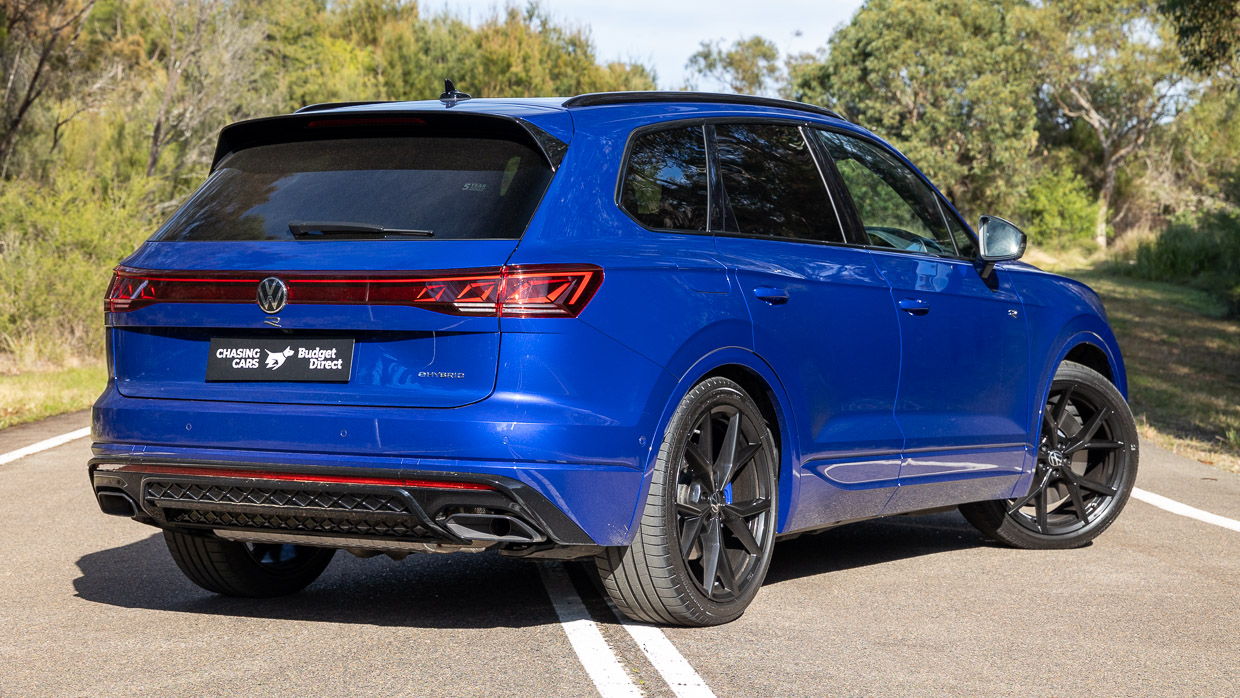
Growth of fully-electric vehicles remains strong in Australia (despite some reports to the contrary), but a large share of the buying public is cautious about fully spurning the convenience of liquid fuel but are open to the idea of combining it with a hybrid system.
For the foreseeable future, there’s a business case in this country for ICE, hybrid, and EV.
Enter the first Volkswagen-badged plug-in hybrid (PHEV) for Australia: the 2024 Touareg R. The brand’s hybrid journey has kicked off at the flagship end, but we anticipate PHEV tech to quickly trickle down even to the smallest end of the lineup: we’re hearing there will be at least one PHEV Golf when that car’s facelift arrives locally.
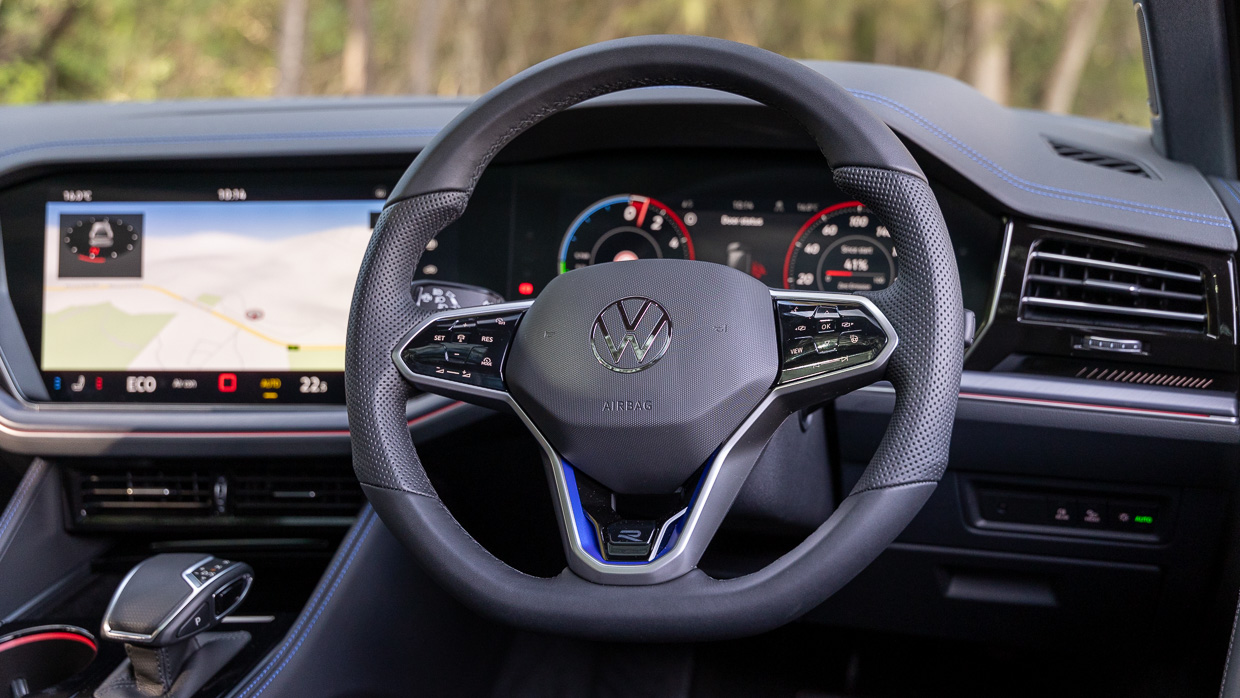
For now, though, the inaugural hybrid is the big daddy of Volkswagens: the large, wide, 2.4-tonne electrified Touareg is also the top-of-the-tree product of VW’s R performance division, with statistics to back it.
This premium SUV’s platform, shared with Audi and Porsche, is spacious enough to get larger engines beneath the bonnet: no four-cylinders here.
Where a regular Touareg has a diesel ‘six, the R switches to a petrol V6 making 250kW on its own, mated to an eight-speed torque converter automatic transmission, AWD system and a 100kW/400Nm electric motor.
Working together, the system can produce 340kW of power and 700Nm of torque – numbers in excess of the top V6 diesel (210kW/600Nm), though the (briefly-offered) V8 diesel of the current-gen made a stonking 310kW/900Nm…
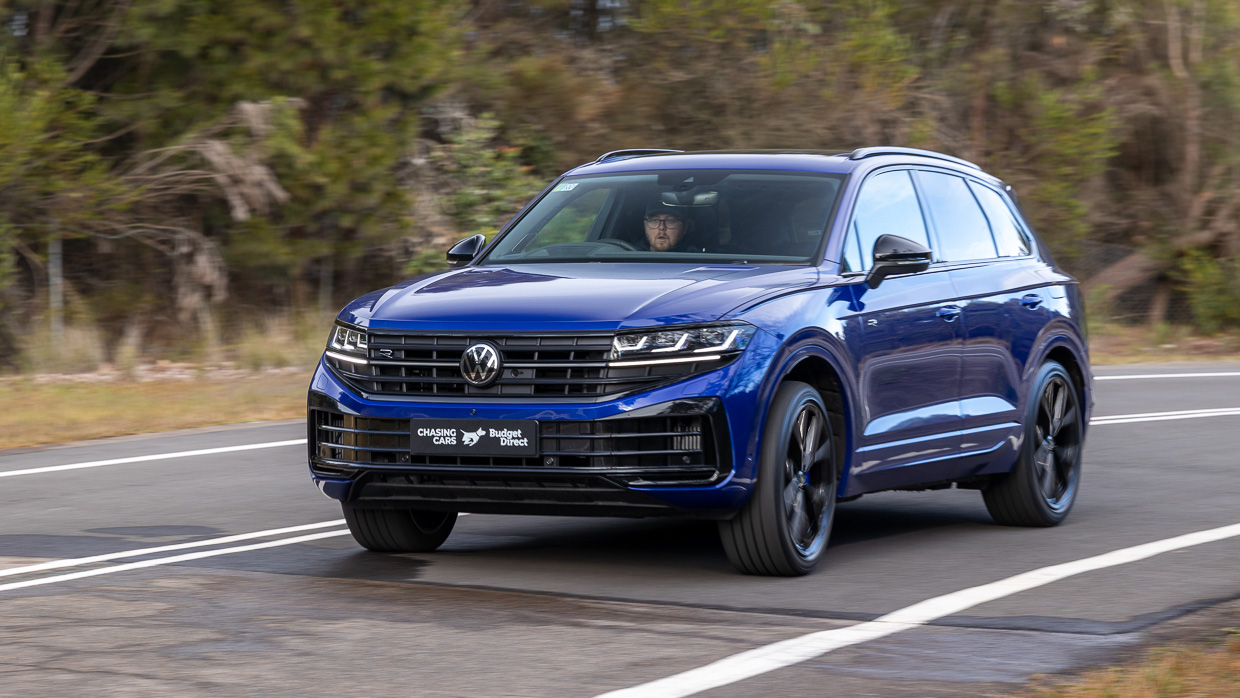
The diesel-eight Touareg was a super-limited run vehicle designed to soak up excess capacity of engines Bentley couldn’t use. The new Touareg R, however, is not to be a short-lived special. Instead, its hybrid system falls into compliance with ever-tighter European emissions regulations.
In favourable conditions – when it’s been charged – it emits an official 48-56g/km of CO2. We found it will easily accomplish 40km and even 50km at a pinch on electric power from an overnight household-outlet charge – and even when the battery is exhausted, the hybrid system gives the assistance it can to the petrol, lowering consumption to an acceptable 9-10L/100km.
In some ways, it’s an R product for a new age. We know the hot VW division is working on a fully-electric product, but for now, the Touareg R is their piece de resistance. So, what’s it like to live with, and to drive?
Given the Touareg R is a large, premium SUV packing a big six-cylinder turbo petrol engine, a plug-in hybrid system and all the expected R mechanical trimmings, a relatively steep price should be expected. Still, the $129,990 tariff before on-road costs – or about $140,000 once the wheels hit the road – is strong money for a Touareg.
It isn’t the dearest Touareg ever: the 2021 V8 TDI was a last-of-the-line sellout at $136,490 before on-roads. If that sounds steep, 2004’s V10 TDI (it was another era…) would now cost a whopping $230,400 once inflation is factored into the $138,500 price the ten-cylinder oiler asked from Aussies around the time of the Athens Olympic Games.
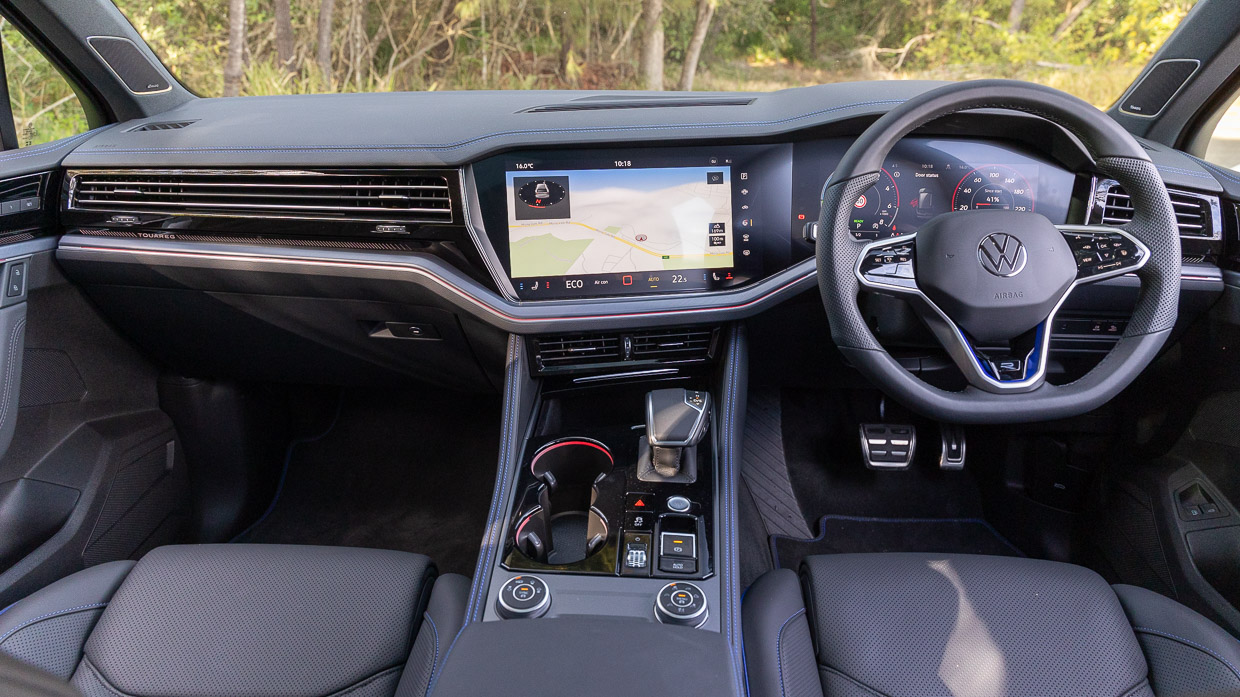
Still, the new R is a $20,000 uplift over the highly capable 210TDI R-Line model (which uses a 210kW/600Nm 3.0-litre V6 diesel), a $30K upcharge over the 210TDI Elegance, and a significant $43,110 leap over the 170TDI entry point. You’d expect it to be loaded; it pretty much is.
Standard kit on the Touareg R takes in:
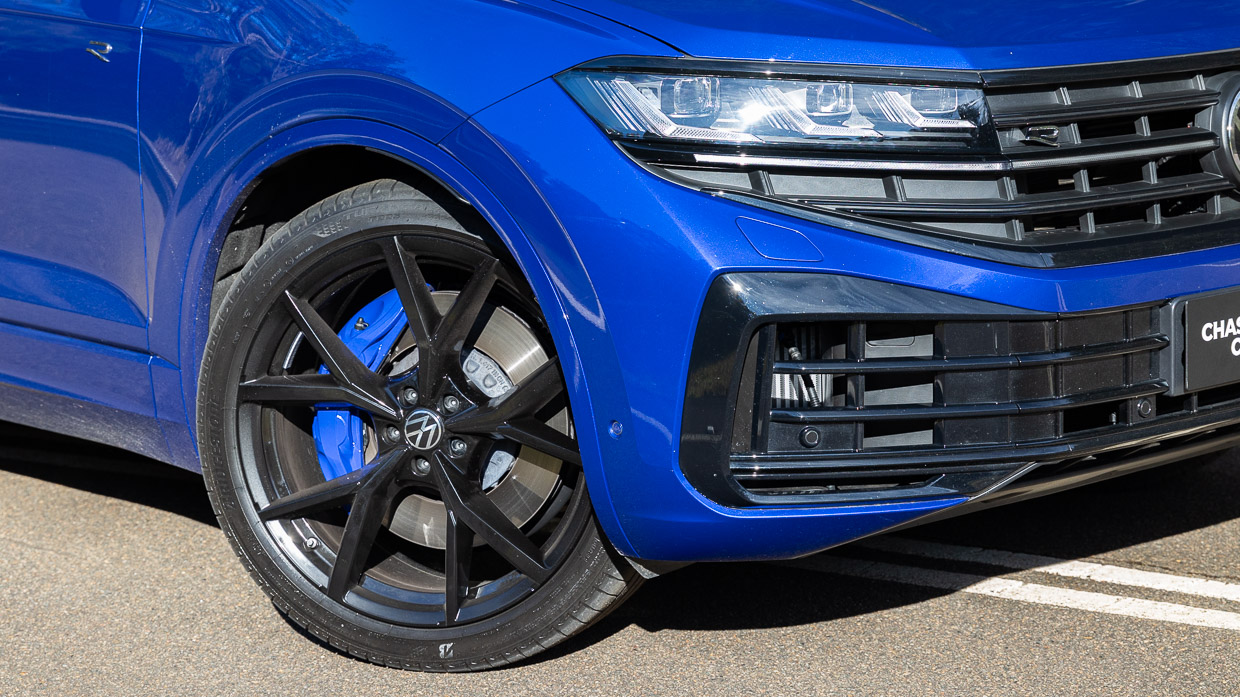
Additional standard equipment relevant to the hybrid system includes:
Commendably, all colours available in Australia for the Touareg R are no-cost options, including the R-specific hero hue Lapiz Blue fitted to our test vehicle. Pure White is the sole solid colour, while the metallic palette takes in Oyster Silver, Silicone Grey, Chili Red, Grenadilla Black, and Meloe Blue.
Unlike the more traditionally-specific Touareg 210TDI Elegance trim ($99,990 before on-road costs), the sole interior colourway for the R variant is Soul Black paired with dark aluminium trim inserts.
Generally speaking: very well indeed.
While plug-in hybrids occasionally serve up the worst of both worlds – lurching pairings of underpowered motors and engines are all-too-common – we are increasingly convinced that Volkswagen Group knows how to develop and tune a PHEV properly, making the electric-petrol combination slick and desirable.
European buyers might have known this for some time, but the choice of Volkswagen-engineered hybrids in Australia has been amazingly thin for years, despite huge evidence that Australians are interested in buying this type of powertrain – at least while EV charging infrastructure grows.
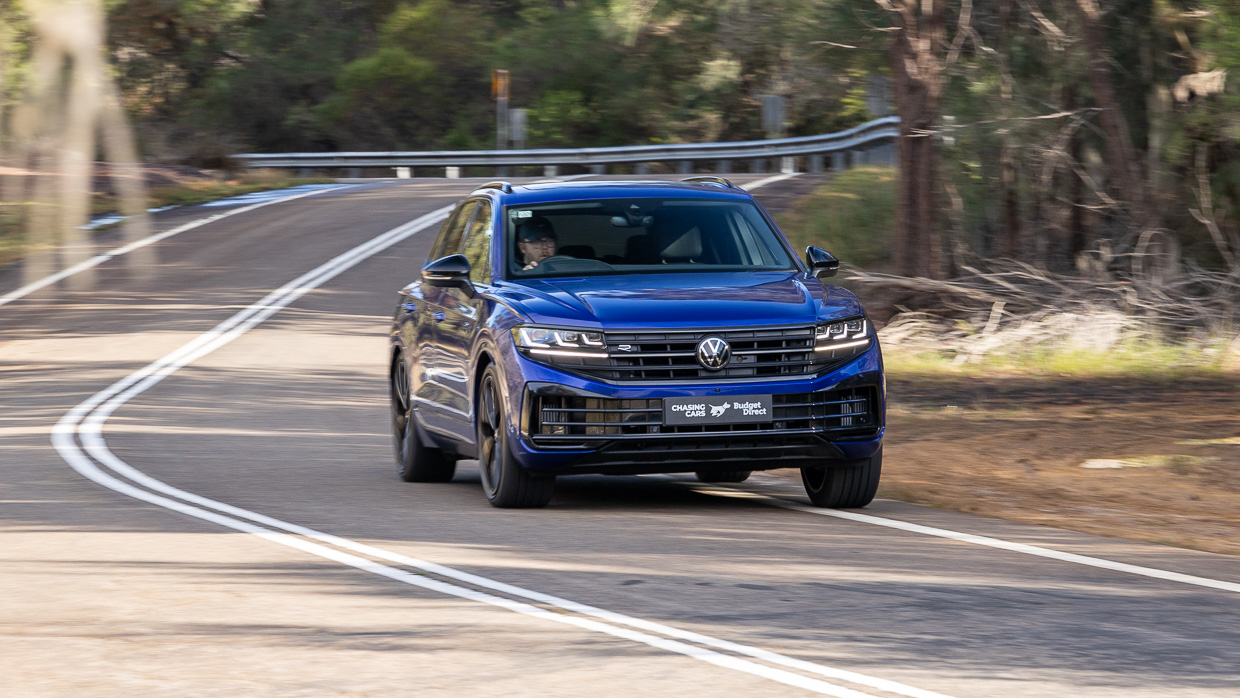
Petrolheads who remain cynical about even hybridisation (let alone full electrification) can rest easy here: the Touareg R doesn’t skimp on the combustion side of the ledger, with a standalone 250kW/450Nm 3.0-litre turbocharged petrol V6 to do the heavy lifting.
There is temptation (and dividend) for PHEV manufacturers to cut back on the petrol engine’s outputs and hope the electric motor can fill in the shortcomings. This works…when there is charge in the battery. But when that runs out, coarse and weedy engines immediately reveal the brand’s choice to cheap-out.
Like the Cupra-branded Volkswagen Group hybrids already on the Australian market in the Leon and Formentor, though, when the underlying engine is reasonably powerful – and turbocharged – once the PHEV battery has run dry, such as on a road trip, you’re not left wondering where all the power has evaporated to.
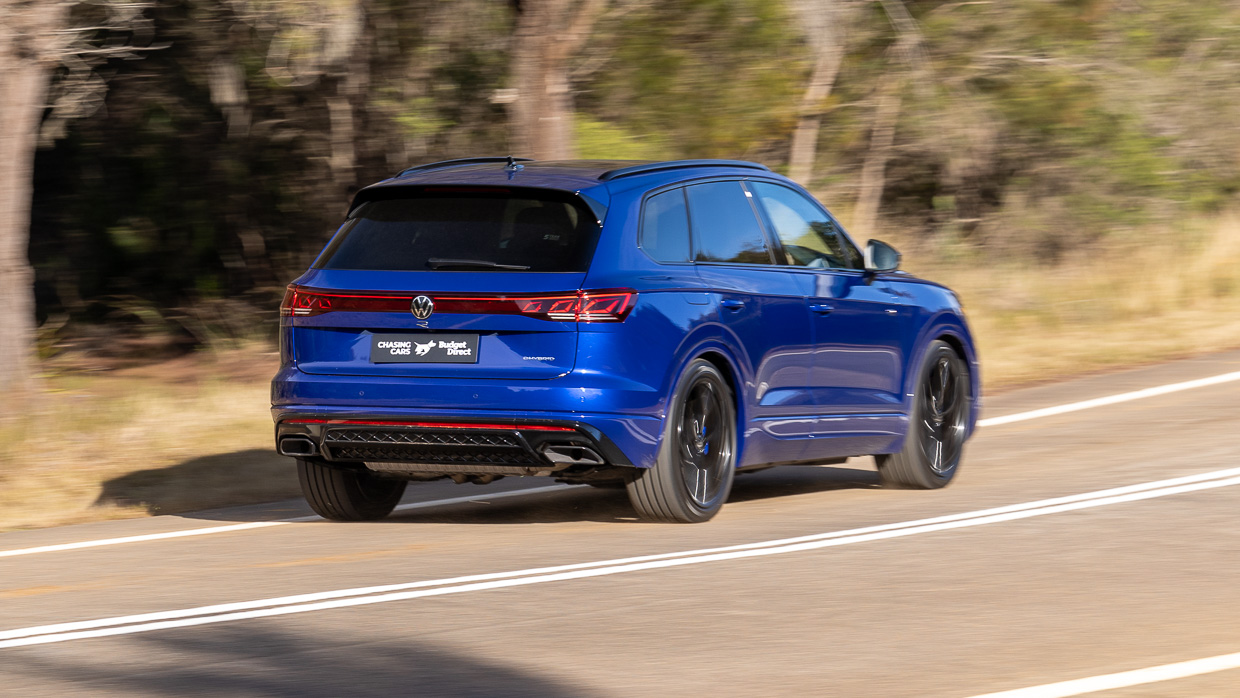
That’s not to say there’s no reason to charge a Touareg R’s battery: you’ll need to do so in order to run on EV mode (with dedicated 100kW/400Nm motor), but where the battery has charge, the headline 340kW/700Nm figure can be achieved for more than just a second or two.
And running the R in sport mode deliberately generates battery charge so the full combined outputs can become a reality even far from your last charge.
Speaking of the former situation – driving on EV mode – while 100kW of electric power sounds very modest (and it is), the 400Nm instant torque means even relatively assertive throttle inputs in Electric settings don’t wake up the engine. For commuting, even where that commute takes in 80-100km/h zones – electric driving is the order of the day.
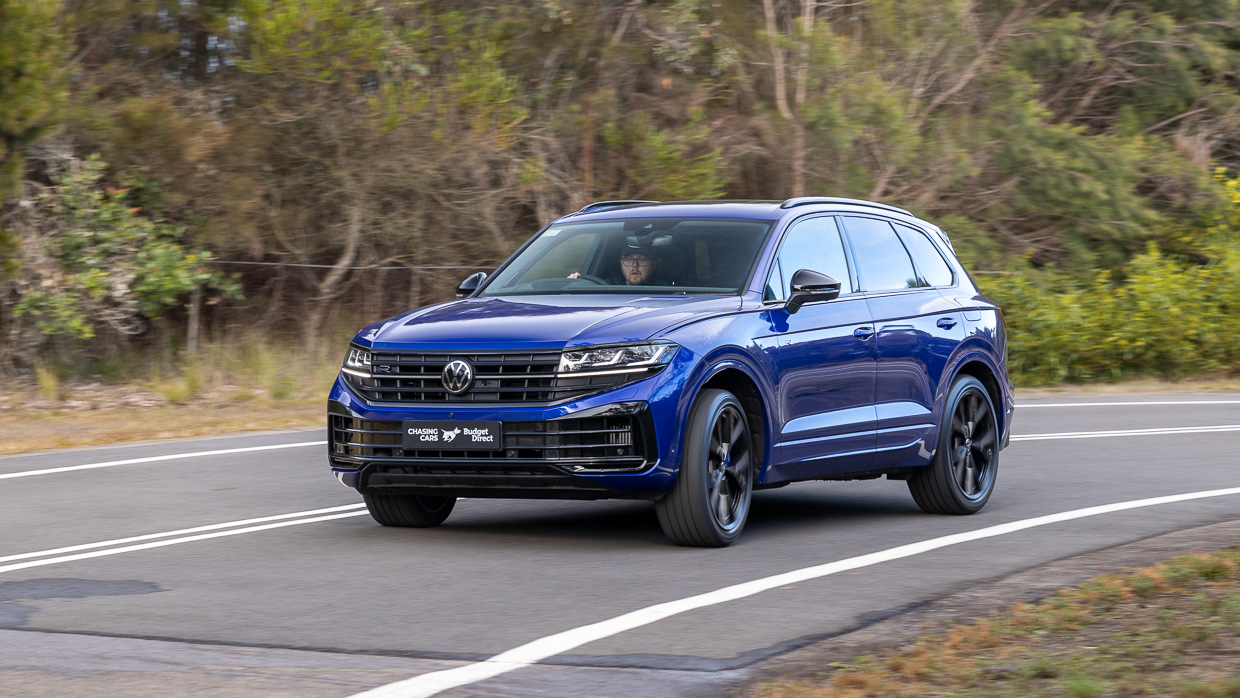
But on the highway and on rural roads, the hefty additional output of the petrol V6 means cross-country performance is really strong even if the exhaust note is a little muted.
Throttle response is rapid, lacking common hybrid ‘weirdness’ in the pedal, and even when the battery appears ‘dead’ you feel electric boosts out of corners thanks to regenerative braking – though the blended brake pedal’s vaguely wooden feel could be slicker.
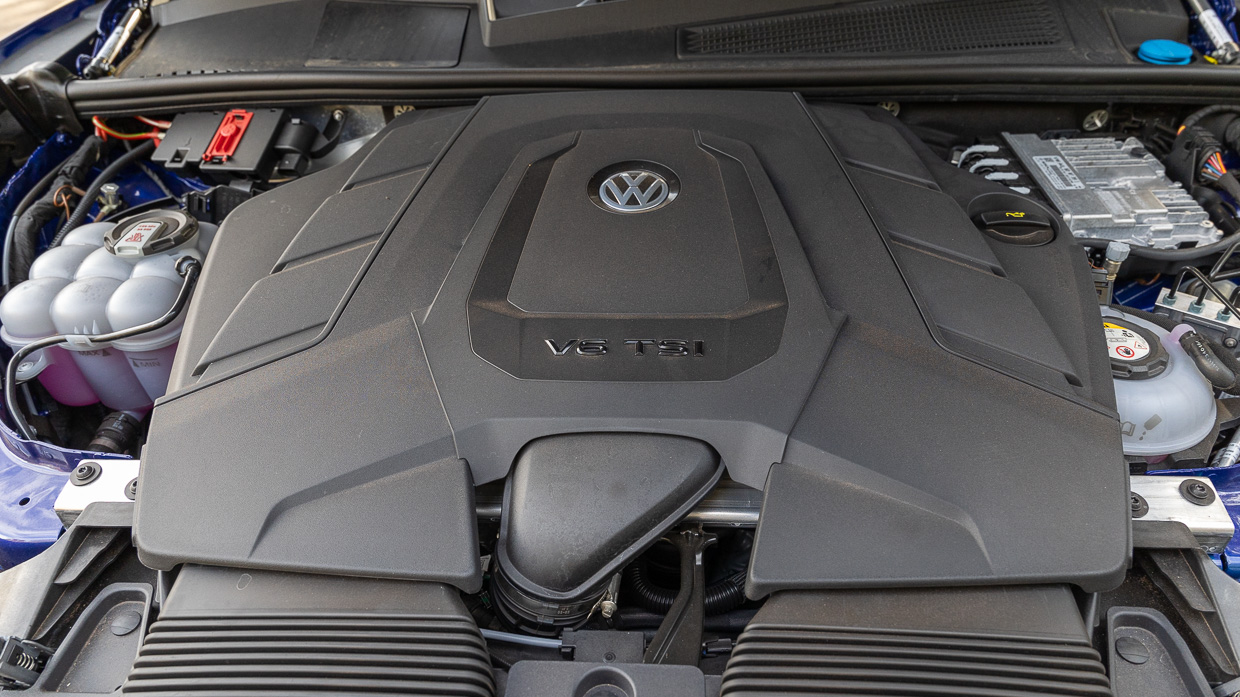
It’s not easy to get the chassis tuning on a PHEV or full EV right due to the sheer weight involved – and the task is frankly more difficult for PHEVs, given they also have to accommodate the weight of the internal combustion engine, gearbox and associated mechanicals…and the Touareg R ups the ante further given it’s a heavier V6 unit.
Yet Volkswagen have done an impressive job here. The Touareg is a relatively nimble and enjoyable large SUV to drive in any form, but the R reaches for heights previously reserved for its platform-sharing cousin, the Audi SQ7/SQ8, even without the trick 48-volt active anti-roll bars that give an uncanny capability to the control surfaces.
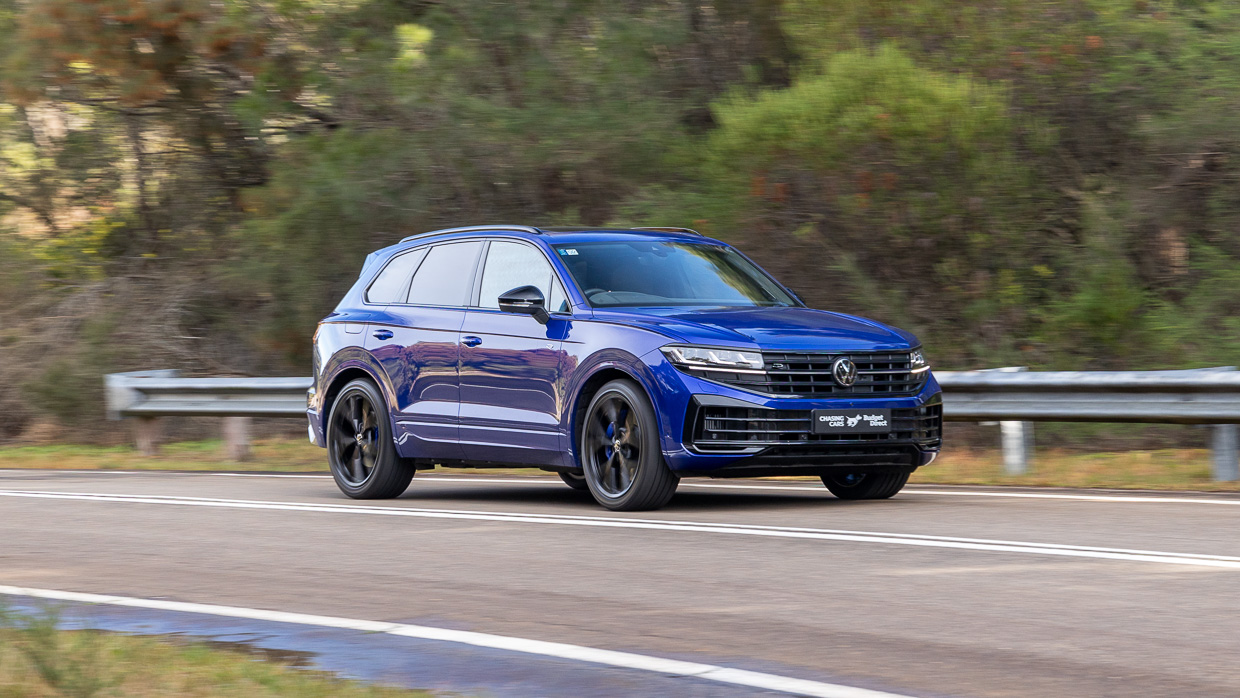
Despite this absence of high-spec handling equipment, the Touareg R isn’t caught lacking. In truth, it actually takes more than a few miles of rural road to get used to how agile and surefooted this 2.4-tonne behemoth can be and how much speed you can consequently carry through bends.
And even without the four-wheel steering offered on the 210TDI R-Line grade, both low-speed maneuverability and higher-speed agility feel strengthened beyond what a standard model can offer.
The R-tuned adaptive air suspension follows through with a noticeably taut but controlled and mostly compliant ride quality, though the huge 22-inch wheels do catch out square-edged imperfections and transmit some unwanted feedback into the cabin.
As the highest-performance example of the refreshed Touareg lineup, the R variant simultaneously introduces a higher-quality interior than the pre-facelift versions, and a number of R-specific cabin elements Australians haven’t seen on this model before.
Like in a Golf R, that means distinctive, darker finishes that subtly communicate sporting intent: a perforated, flat-bottom sports steering wheel with paddle shifters, carbon-like surfacing about the place, generous use of R-spec Lapiz Blue leather stitching, and plenty of R logos appearing on hardware and in software.
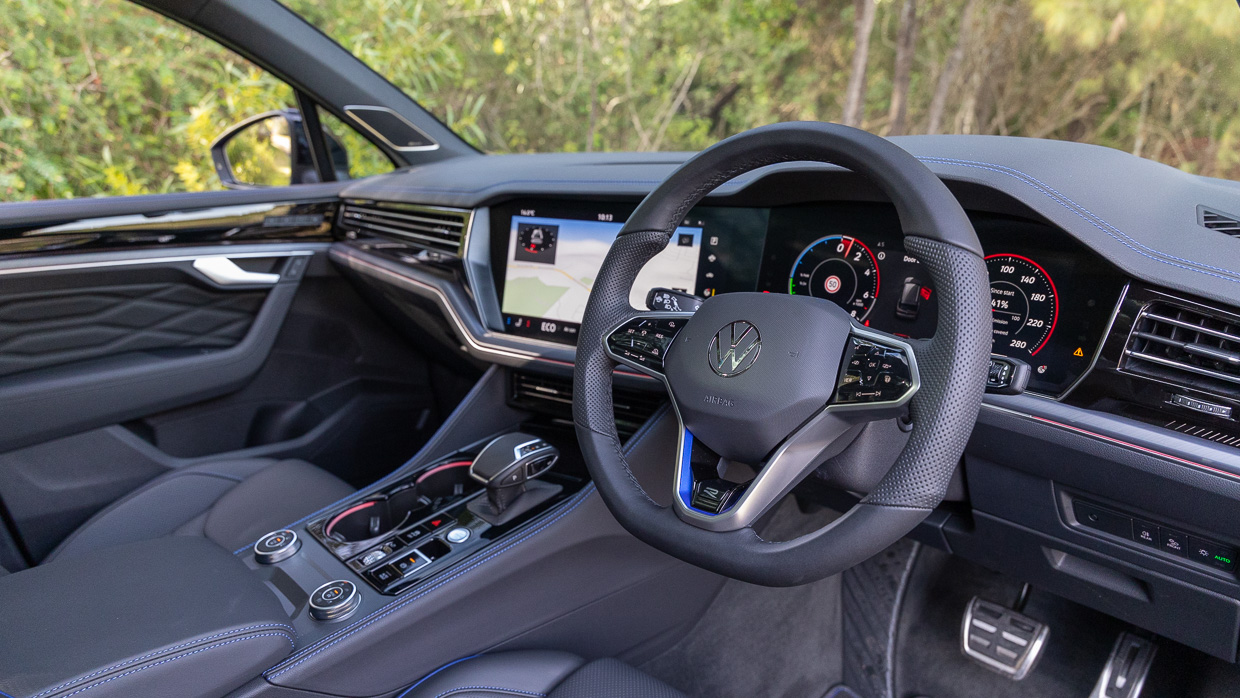
But the cabin of the Touareg R isn’t a massive leap over the $20,000-cheaper diesel R-Line model – it’d take a committed Volkswagen spotter to rapidly tell them apart. Most of the cost uplift goes to the mechanical changes, although the generous standard specification means there isn’t a single option box to choose.
As in other Touaregs, the seats – certified by a German ergonomics institute – are big, comfy and lazy in default settings.
While the on-seat electric controls make it seem like there are only the expected 12 ways of adjustment, the central touchscreen houses more extensive customisation: upper and lower bolsters can be tightened or loosened.
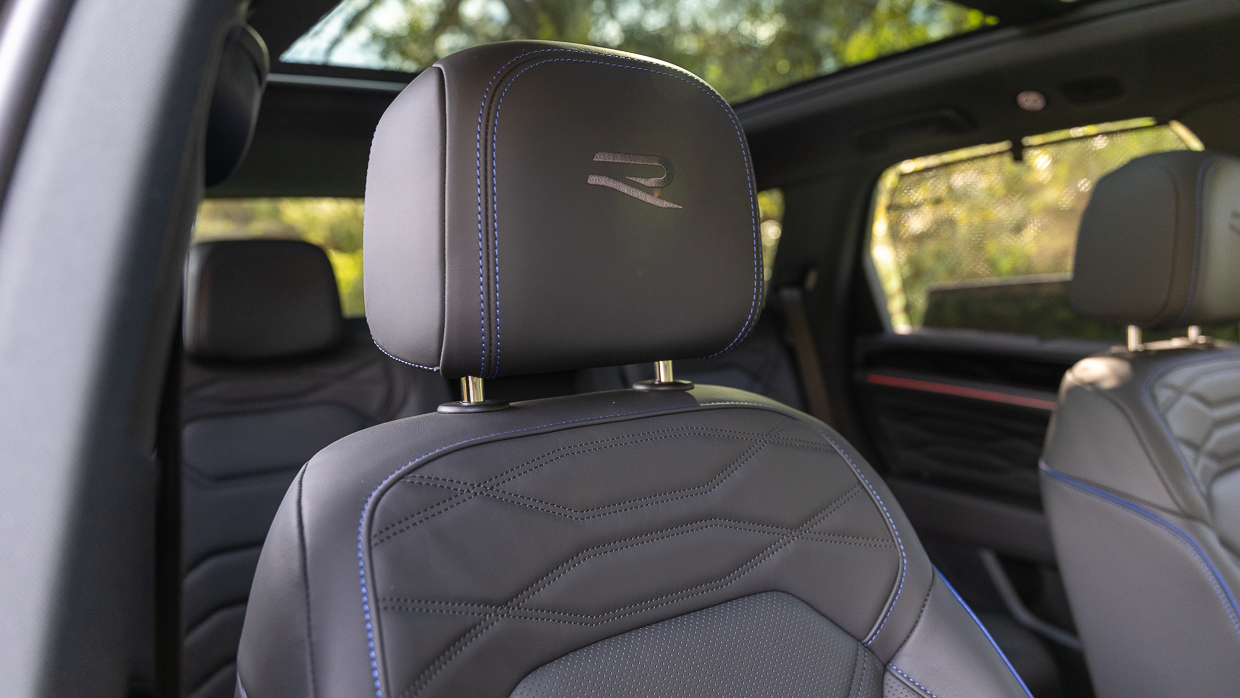
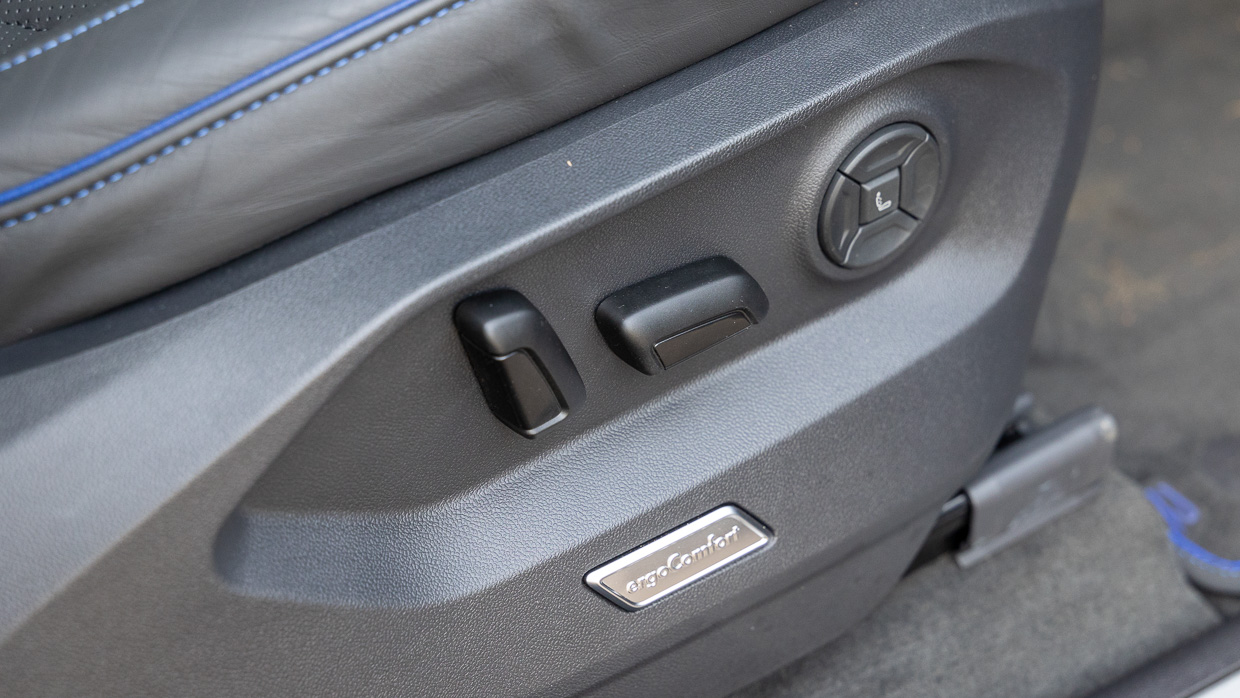
The front pews also massage, which was of particular utility on our highway test of the R. The programmes are genuinely soothing and enjoyable…especially because we didn’t find the seats themselves to be the last word in back support.
More fiddling with lumbar might help or it may just be our body shape, but we’d recommend an extended test drive to check that the seat fit is good for you.
We liked the seat trimming, though: the ‘Puglia’ nappa leather is soft and premium, although opting for R means black is the sole interior colour-way, and it’s definitely dark and broody. Heating and cooling keeps the chair surfaces temperate year-round.
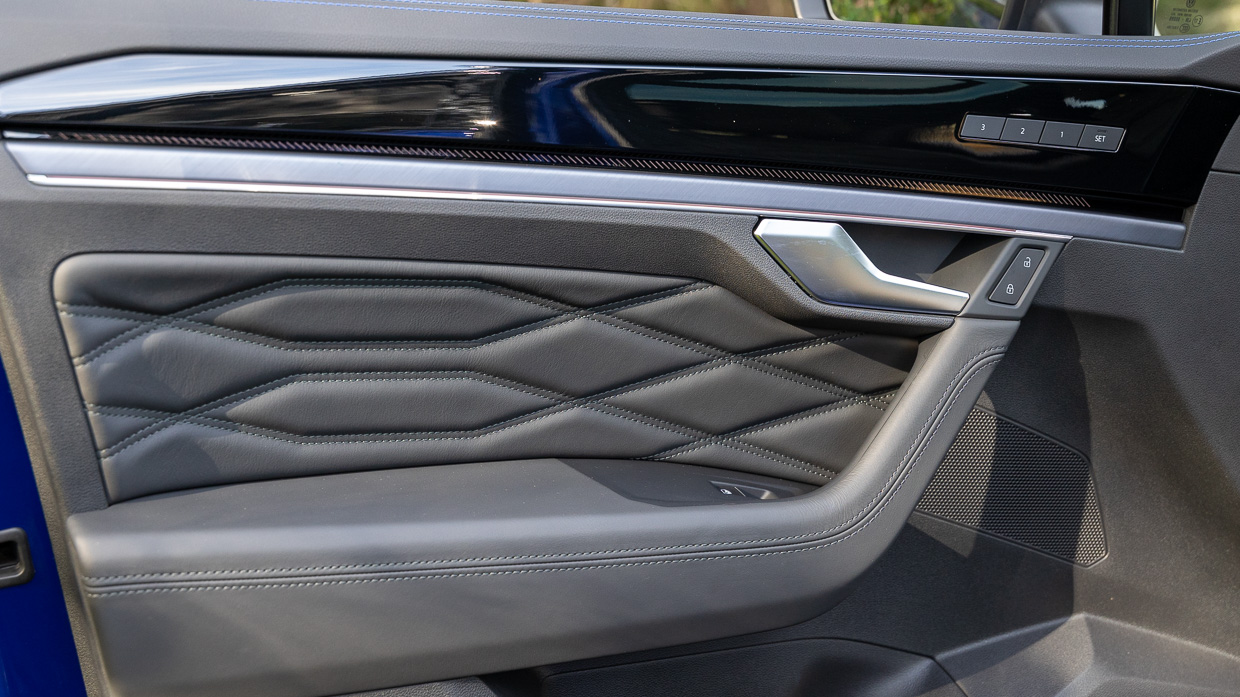
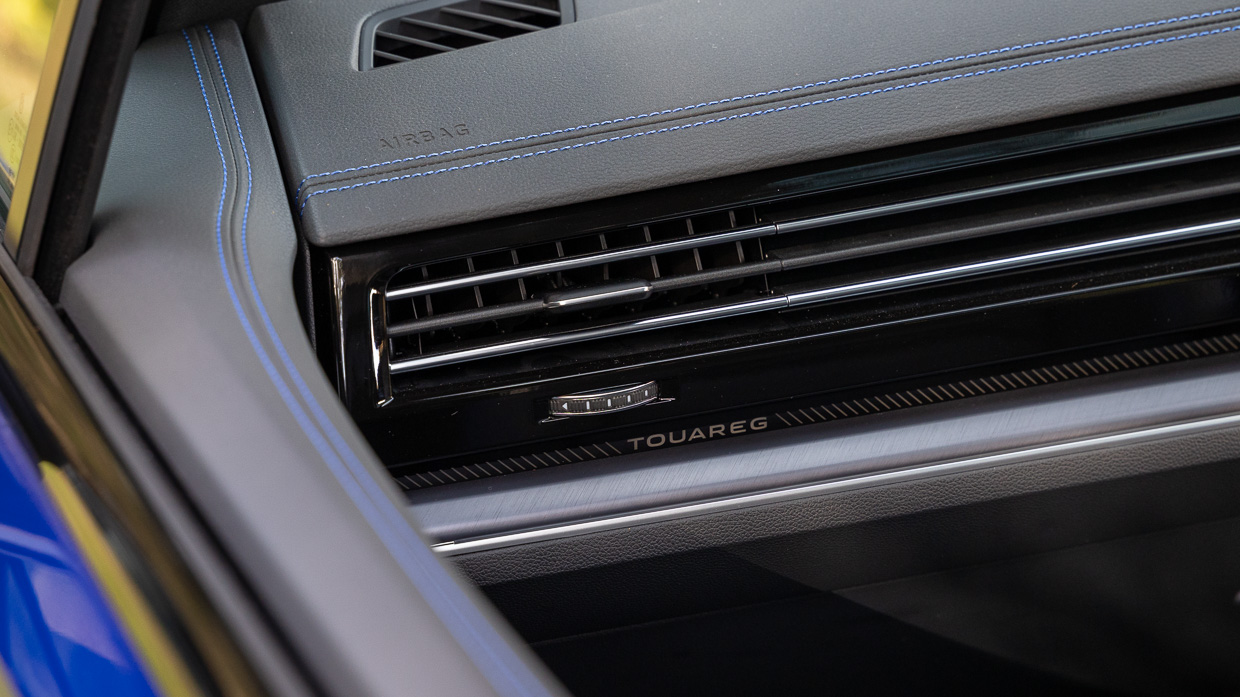
Surface material quality has taken a noticeable step up in the Touareg.
It should have been this way all along – after all, this model is Volkswagen’s flagship – but before the updates, hard and scratchy surfaces were conspicuous in places like where a driver’s leg rests against the centre console. That’s all been fixed, with softer and more supple treatments the new default.
Previously optional on some variants, all facelift Touaregs (including the R – naturally) adopt a broad 15-inch central touchscreen that continues to impress. It’s bigger than the unit fitted to nearly any rival. Software is updated, too, with easier-to-press touch targets and (finally) full-screen Apple CarPlay and Android Auto.
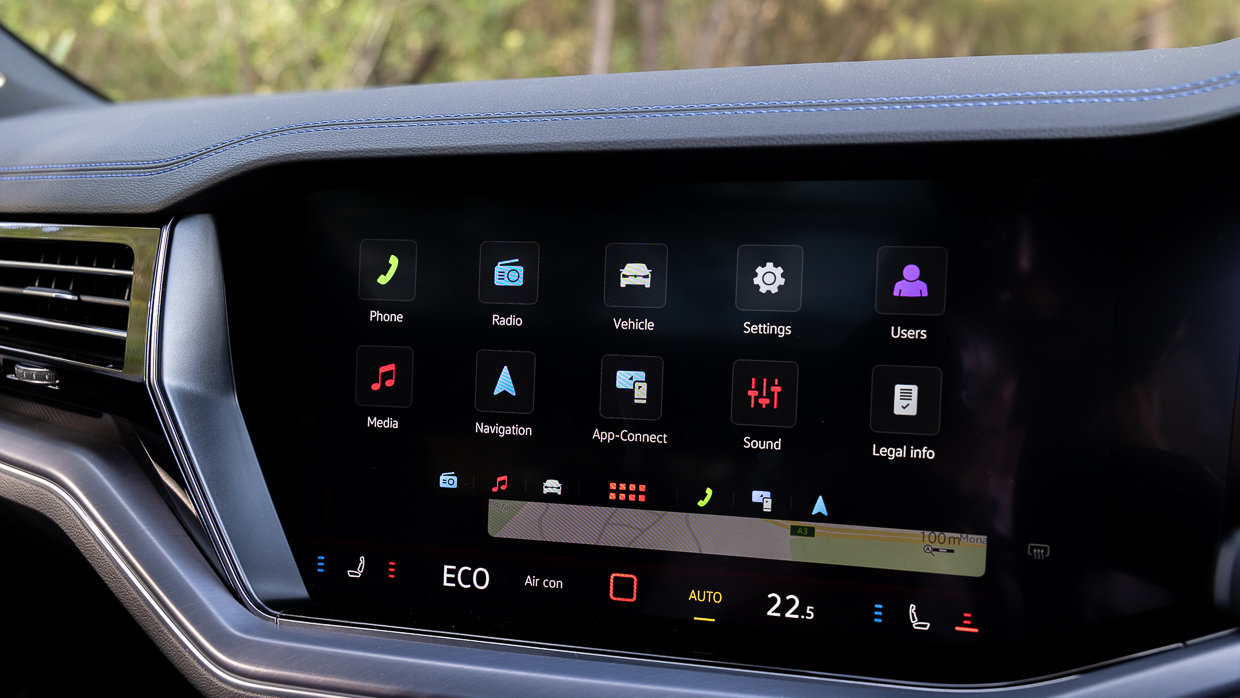
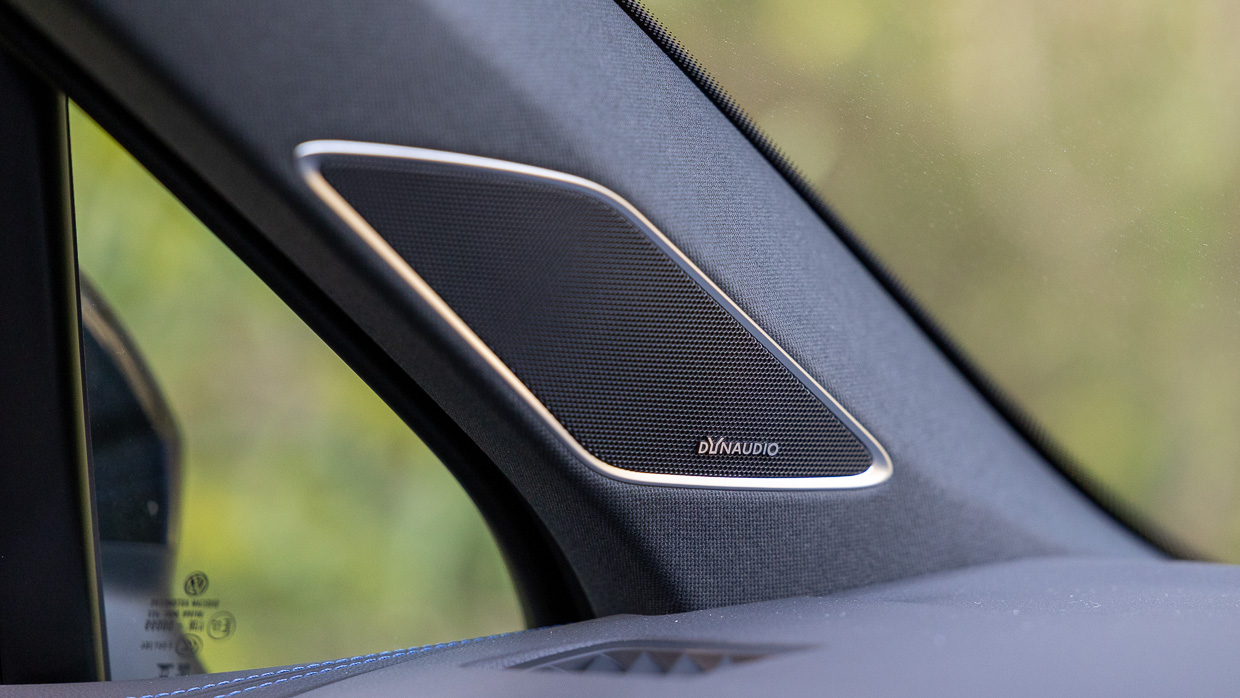
Equally impressive is the 12-inch digital instrument cluster which is especially high resolution, and packing extensive customisation.
A full map can be situated in front of the driver; alternatively, media, safety and trip computer information can be given pride of place while ancillary readouts can be selected to sit within (or replace) skeuomorphic representations of analogue dials.
Appreciated hard buttons have been retained for some functions, like a volume roller. Climate is on-screen – normally a non-issue, but oddly, adjusting the temperature blanks-out CarPlay for a few seconds: a bug that should have been squashed in development.
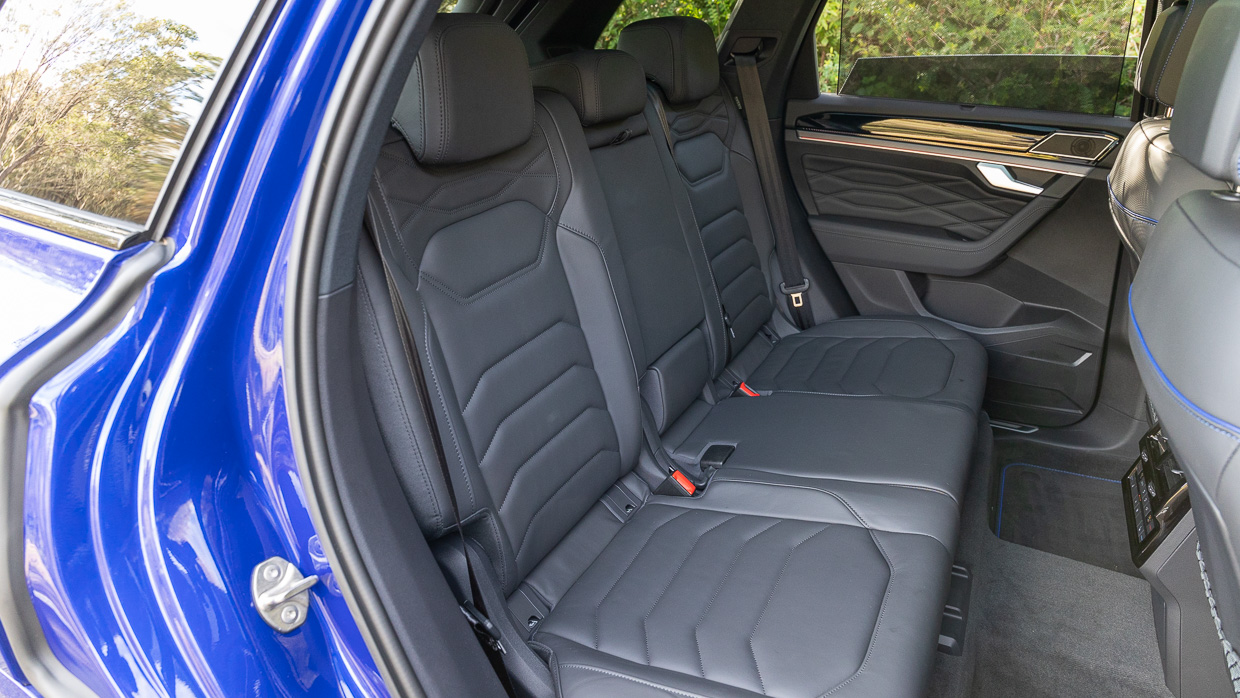
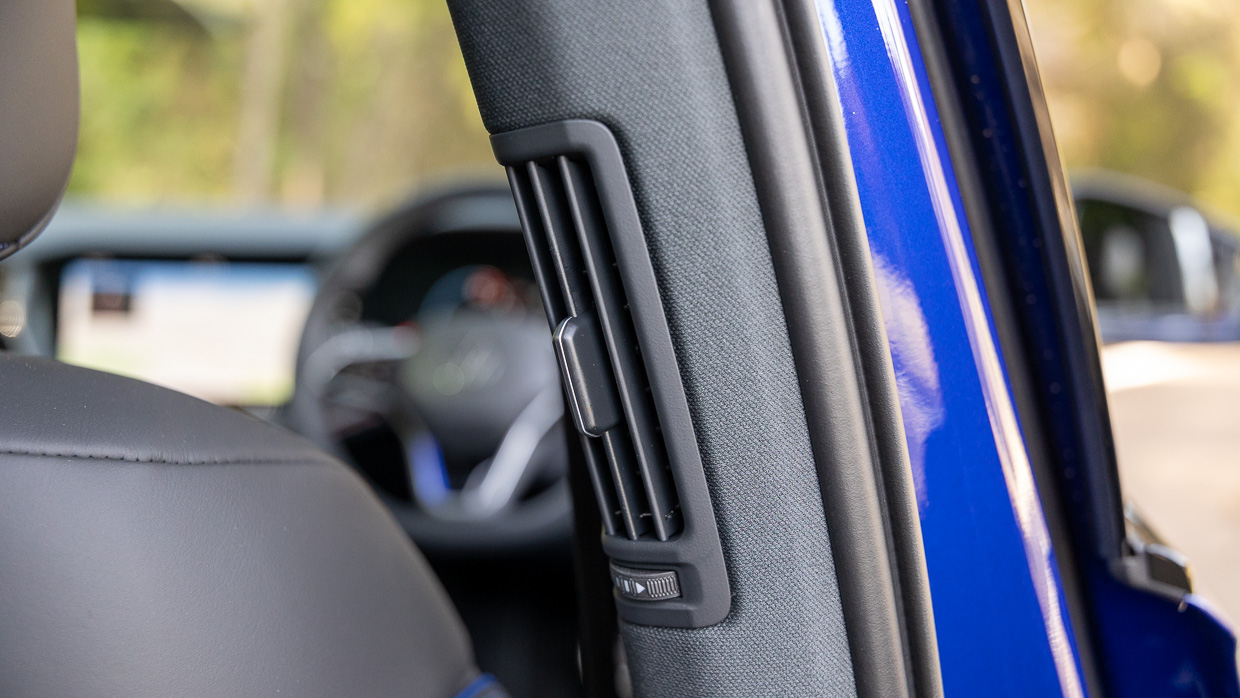
And the Touareg R is also blighted with easy-to-bump capacitive steering wheel shortcuts – surely one of the final releases with this feature before the brand’s promise to return to physical buttons arrives in-market.
Audio is by way of a Dynaudio unit from the Nordic brand’s upper-spec Consequence line. We found that establishing a clear sound required a fair bit of fiddling with the EQ settings, but we got there – and the system is certainly powerful.
As you’d expect for a relatively large SUV with just five seats, the second row is really generous with plenty of space for adult or child occupants alike.
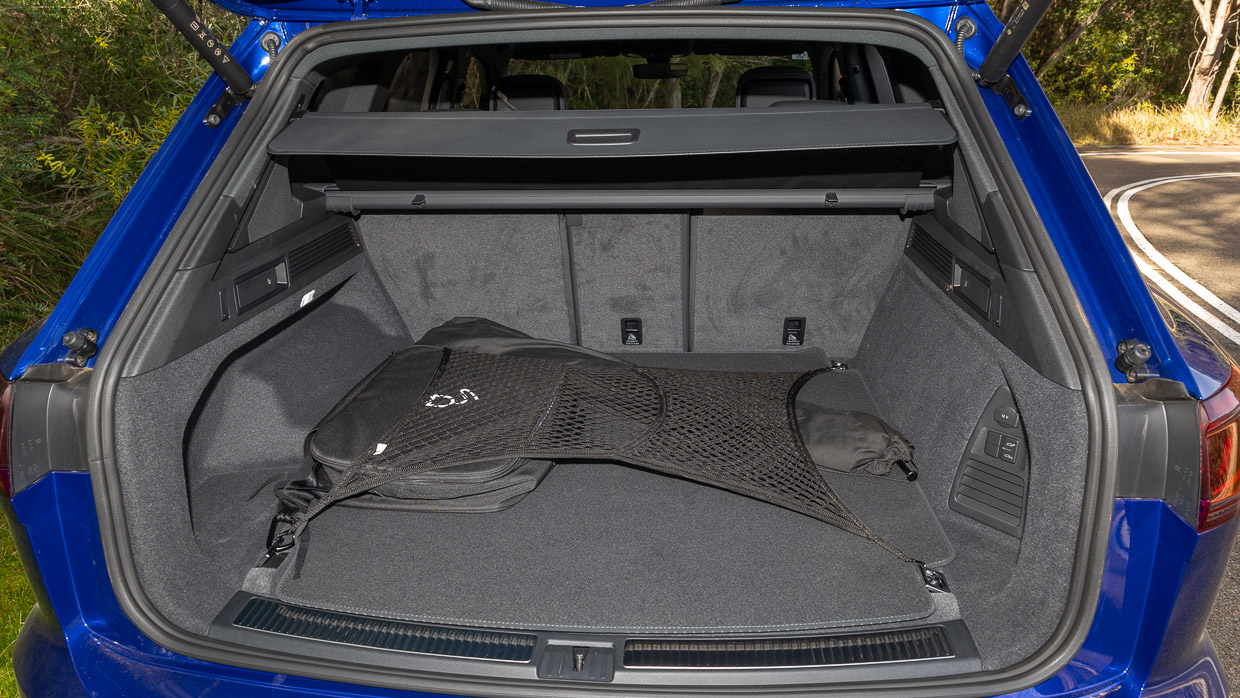
Legroom, headroom and toe room for six-footers all get high marks, while air vents, USB-C ports, a broad centre armrest, soft-touch rear door plastics and integrated window sun blinds round out solid back seat accommodations.
Storage is reasonable though not hugely generous for a car of this size: medium-size cupholders up front sit ahead of a surprisingly shallow bin beneath the (adjustable) centre armrest. Door pockets are large and flock-lined, however.
The boot measures a vast 810 litres and sits behind a power opening door; the Touareg’s air suspension can be lowered remotely from the boot area to make loading heavy stuff less of a lift. No spare wheel is fitted to the petrol-hybrid R; all diesel models get a space-saver.
Yes. The current-generation Volkswagen Touareg received a 2018-vintage five-star crash and safety rating from Australian new car safety testing body ANCAP – although this rating will officially expire (by timing-out) in December 2024. Volkswagen will need to choose whether to bother having the car re-tested at that point.
Individual scores back in 2018 were good: 89 percent for adult occupant protection, 88 percent for child occupant protection, 72 percent for vulnerable road user (pedestrian and cyclist) protection, and 78 percent for safety assistance tech – noting the latter category was considerably more lenient six years ago.
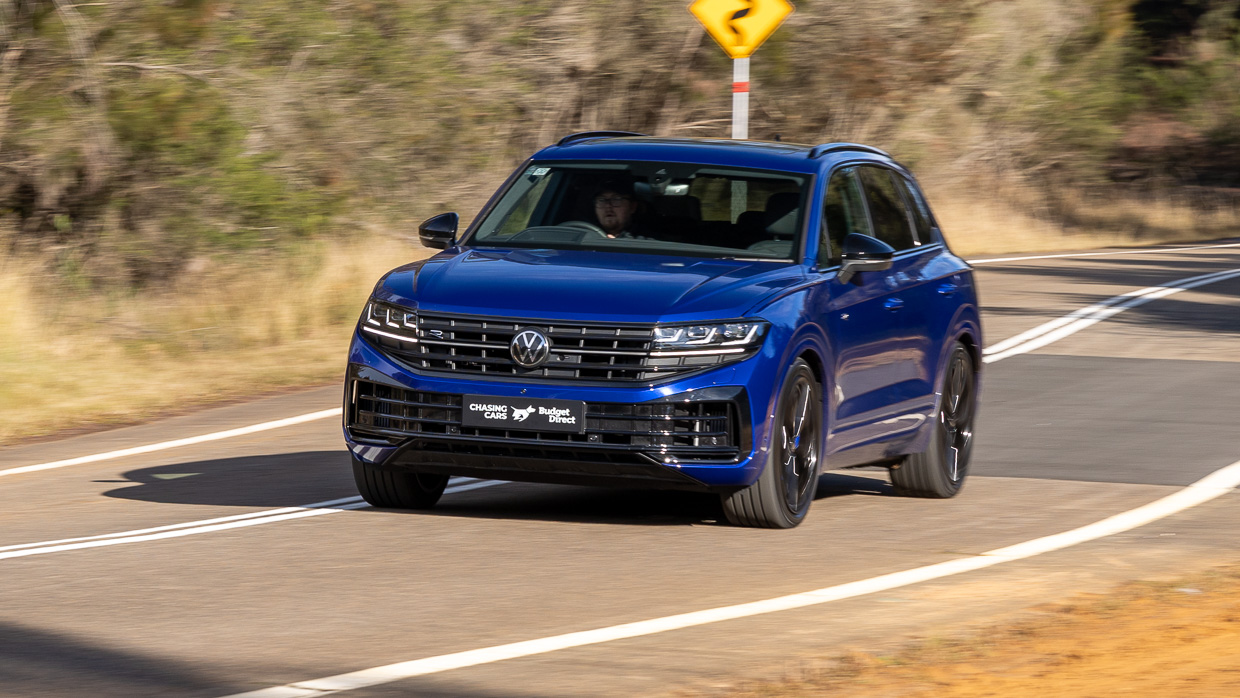
That said, Volkswagen hasn’t kept the Touareg static in terms of its assist tech during that time and the platform has been upgraded with new sensors and computing power since.
We tested a number of the Touareg R’s safety assistance features during our road test. Of particular utility is Travel Assist, which is an overlay for strong adaptive cruise control and lane centring technology which is effective on well-marked highways. We found the Touareg R effectively held lanes and reduced fatigue especially when traffic was light.
The blind spot monitoring, front and rear cross-traffic alert systems and 360-degree camera all ticked the boxes without causing any problems.
That depends on how you’re going to run the vehicle. Volkswagen product planners tell us that the (first) owners of the Touareg R more than probably have a garage, as well as the capacity – and interest – to bother charging the vehicle at home.
You’ll want to do so in order to achieve two things: lowering running costs and boosting the car’s performance potential.
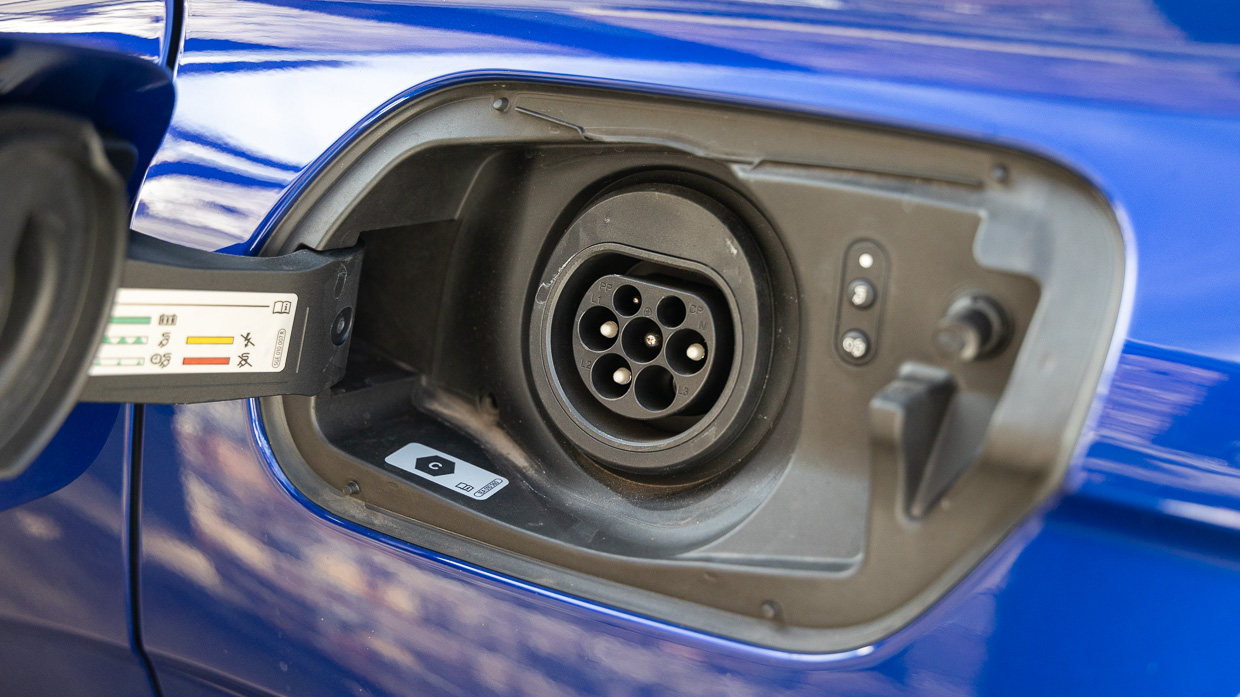
Fully topping off the Touareg R’s 14.3kWh (usable) battery can be done overnight from a standard household power outlet or in just 2.5 hours from an installed single-phase AC wallbox – maximum charging power is 7.2kW. Some plug-in hybrids have faster, DC charging capabilities but for most PHEV users this is overkill for the foreseeable future.
We achieved between 40km and 51km on a single charge depending on our level of assertiveness – that equates to electric efficiency of 28kWh/100km to 35kWh/100km – not at all impressive if this was an EV and even among PHEVs, it’s thirsty.
But that kind of range will be enough for most to commute for a day or two with zero tailpipe emissions.
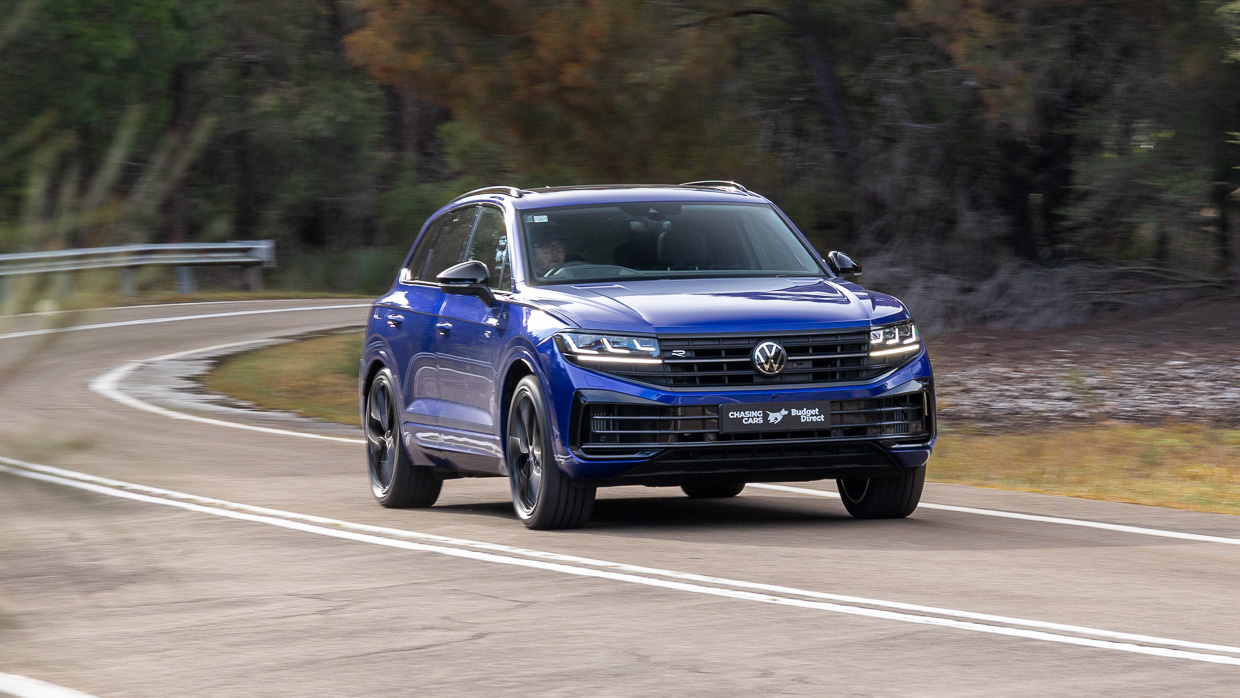
For the commute, where you’re not able to tap into the Touareg R’s 340kW combined power anyway, you want to be running on electric. Why? Apart from serenity, mainly cost. This rig returns low-double digit urban fuel economy relying only on the V6. 100km this way costs about $25 at $2.00/litre.
Paying $0.35/kWh for peak-time electricity, the same 100km of electric running would cost $11 to $14, including charging losses.
Stretching the Touareg R’s petrol-fuelled legs at higher speeds and over longer distances sees more miserly consumption of around 9L/100km, which is acceptable for a hybrid SUV of this size, power, and weight.
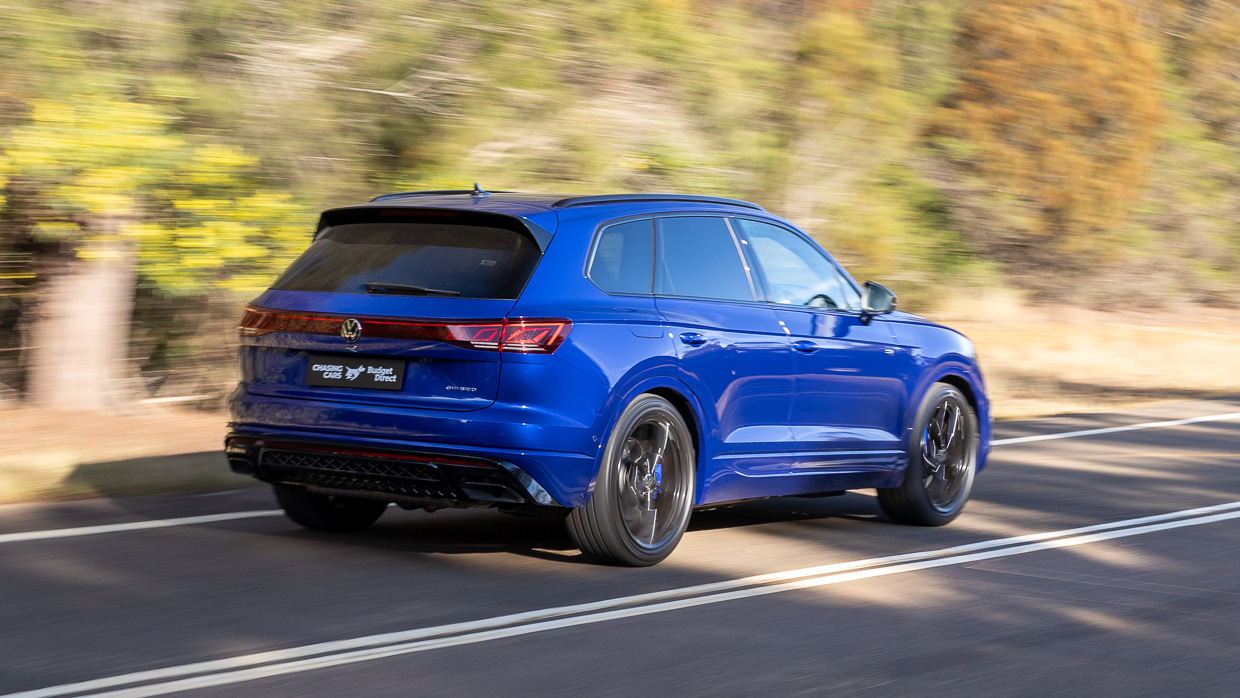
It’s worth noting the presence of a 75-litre fuel tank, which extends touring range out to around 830km on the combustion engine alone – although the diesels can do 1000km and beyond.
It’s possible to pre-purchase a five-year servicing plan for the Touareg R, locking in today’s prices and ensuring you don’t have to pull out your wallet for scheduled maintenance every 12 months/15,000km: this costs $3400 total, averaging out to $680 per year (not bad when you consider the sheer complexity of the vehicle).
Warranty is Volkswagen Australia’s five years/unlimited kilometre coverage for the vehicle.
A comfortable urban bruiser (with the capability for full-electric running), a supple highway cruiser with a relaxed V6 engine, and a seriously athletic SUV able to tackle tough Australian B-road tarmac, the Touareg R makes a convincing case as a do-it-all luxury-sports SUV.
At about $140,000 on-road, the Touareg R is expensive – but in many ways it feels up to the sticker because of its sheer breadth of ability. Here’s a genuinely good hybrid that allows buyers to try out electric commuting and home charging without foregoing petrol power, V6 muscularity, and long-range touring ease.
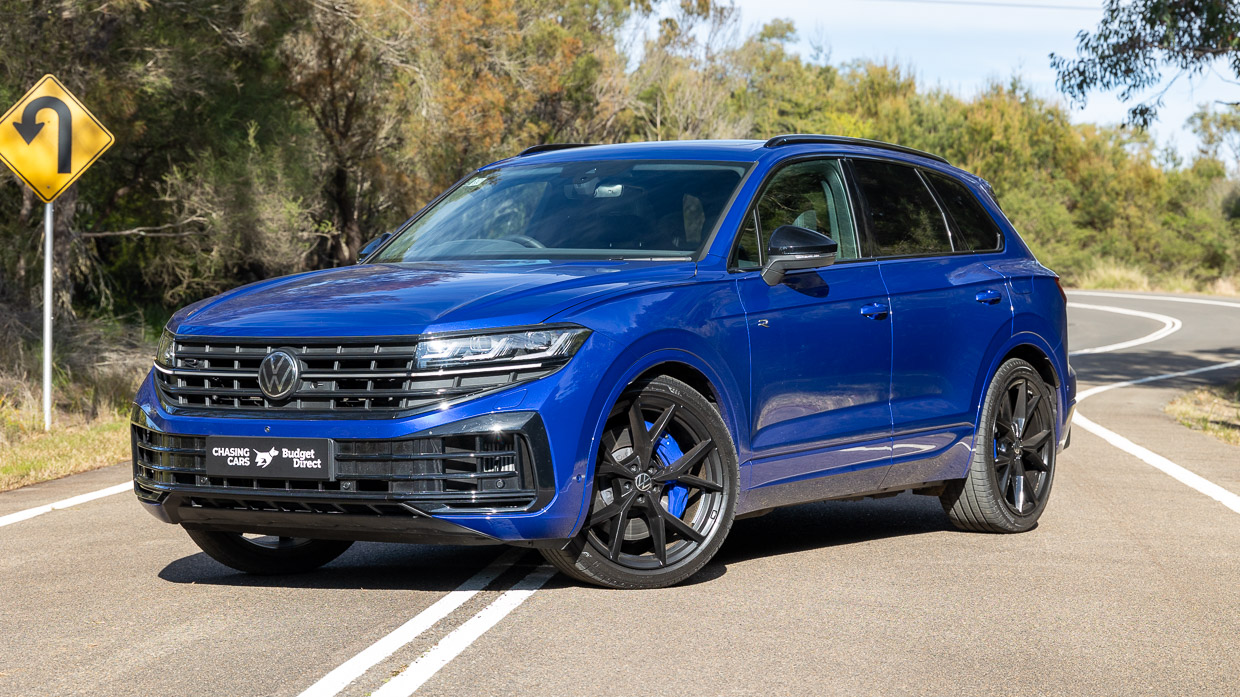
The recipe works so well that we’d like to see another plug-in hybrid Touareg model targeted at non-R customers – for instance a luxury-spec Elegance that offers additional visual customisation, smaller wheels and a slightly softer ride.
We ultimately suspect the Touareg R is a stop-gap on the way to Australia’s charging network being reliable enough to convince its target demographic into a premium electric sports SUV – but given the nascence of that infrastructure, the Touareg R feels like the right car at the right time for those shopping in this segment.
Key specs (as tested)
About Chasing cars
Chasing Cars reviews are 100% independent.
Because we are powered by Budget Direct Insurance, we don’t receive advertising or sales revenue from car manufacturers.
We’re truly independent – giving you Australia’s best car reviews.
The estimate provided does not take into account your personal circumstances but is intended to give a general indication of the cost of insurance, in order to obtain a complete quote, please visit www.budgetdirect.com.au. Estimate includes 15%^ online discount.
^Conditions Apply
Budget Direct Insurance arranged by Auto & General Services Pty Ltd ACN 003 617 909(AGS) AFSL 241 411, for and on behalf of the insurer, Auto & General Insurance Company Limited(ABN 42 111 586 353, AFSL 285 571).Because we don’t know your financial needs, we can’t advise you if this insurance will suit you. You should consider your needs and the Product Disclosure Statement before making a decision to buy insurance. Terms and conditions apply.
Indicative quote based on assumptions including postcode , 40 year old male with no offences, licence suspensions or claims in the last 5 years, a NCD Rating 1 and no younger drivers listed. White car, driven up to 10,000kms a year, unfinanced, with no modifications, factory options and/or non-standard accessories, private use only and garaged at night.
^Online Discounts Terms & Conditions
1. Discounts apply to the premium paid for a new Budget Direct Gold Comprehensive Car Insurance, Third Party Property Only or Third Party Property, Fire & Theft Insurance policy initiated online on or after 29 March 2017. Discounts do not apply to optional Roadside Assistance.
2. Discounts do not apply to any renewal offer of insurance.
3. Discounts only apply to the insurance portion of the premium. Discounts are applied before government charges, taxes, levies and fees, including instalment processing fees (as applicable). The full extent of discounts may therefore be impacted.
4. We reserve the right to change the offer without notice.